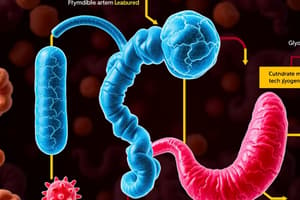Podcast
Questions and Answers
Which enzyme converts fructose-6-phosphate to fructose 2,6-bisphosphate?
Which enzyme converts fructose-6-phosphate to fructose 2,6-bisphosphate?
What is the renal threshold for glucose reabsorption?
What is the renal threshold for glucose reabsorption?
Which coenzyme is not required by the pyruvate dehydrogenase complex for the oxidative decarboxylation of pyruvate to acetyl CoA?
Which coenzyme is not required by the pyruvate dehydrogenase complex for the oxidative decarboxylation of pyruvate to acetyl CoA?
What does the action of hexokinase on fructose produce?
What does the action of hexokinase on fructose produce?
Signup and view all the answers
Which disorder is characterized by decreased renal tubular reabsorption of glucose and amino acids?
Which disorder is characterized by decreased renal tubular reabsorption of glucose and amino acids?
Signup and view all the answers
Which metabolic pathway is entirely anabolic?
Which metabolic pathway is entirely anabolic?
Signup and view all the answers
What is the main difference between aerobic and anaerobic glycolysis in terms of ATP yield?
What is the main difference between aerobic and anaerobic glycolysis in terms of ATP yield?
Signup and view all the answers
Which cycle involves both cytoplasmic and mitochondrial processes?
Which cycle involves both cytoplasmic and mitochondrial processes?
Signup and view all the answers
What is a key enzyme in gluconeogenesis?
What is a key enzyme in gluconeogenesis?
Signup and view all the answers
Which coenzyme is essential for the HMP shunt?
Which coenzyme is essential for the HMP shunt?
Signup and view all the answers
What is the primary product of glycogenolysis in the liver?
What is the primary product of glycogenolysis in the liver?
Signup and view all the answers
Which process is primarily responsible for generating NADPH + H?
Which process is primarily responsible for generating NADPH + H?
Signup and view all the answers
What is required for the process of glycogenesis?
What is required for the process of glycogenesis?
Signup and view all the answers
Study Notes
Carbohydrate Metabolism Revision
- Anabolic Pathways: Glycogenesis, Gluconeogenesis
- Catabolic Pathways: Glycolysis, Oxidative decarboxylation, Krebs cycle, HMP shunt, Uronic acid pathway, Glycogenolysis
- Amphibolic Pathway: Krebs cycle
Aerobic and Anaerobic Glycolysis
- Aerobic glycolysis of glucose yields 36-38 ATP
- Anaerobic glycolysis yields 2 ATP
- Complete oxidation of one glucose molecule yields 36-38 ATP
- Oxidative decarboxylation of two pyruvate molecules gives 6 ATP
- Oxidation of one acetyl CoA yields 12 ATP
Substrate-Level Phosphorylation
- Glycolysis: Phosphoglycerate kinase and pyruvate kinase
- Krebs Cycle: Succinate thiokinase
Coenzymes
- HMP shunt: NADP
- Glyceraldehyde-3-phosphate dehydrogenase: NAD
- Succinate dehydrogenase: FAD
Uronic Acid Pathway
- Important for producing glucuronic acid (detoxification, vitamin C synthesis in animals)
- UDP-glucuronic acid is involved in conjugation reactions.
HMP Shunt
- Important for NADPH + H and ribose-5-phosphate production
Key Enzymes
- Glycolysis: Hexokinase, glucokinase, phosphofructokinase-1, pyruvate kinase
- Krebs Cycle: Citrate synthase, isocitrate synthase, α-ketoglutarate dehydrogenase
- HMP Shunt: Glucose-6-phosphate dehydrogenase
- Glycogenesis: Glycogen synthase
- Glycogenolysis: Glycogen phosphorylase
- Gluconeogenesis: Pyruvate carboxylase, phosphoenol pyruvate carboxykinase, fructose 1,6-biphosphatase, glucose-6-phosphatase
Glycogen Metabolism
- Glycogenesis: Requires glycogen synthase, UDP-glucose, and a branching enzyme.
- Glycogenolysis: Requires glycogen phosphorylase, inorganic phosphate, glucan transferase, and a debranching enzyme.
- Liver glycogenolysis produces free glucose due to glucose-6-phosphatase. Muscle glycogenolysis does not.
Other Important Cycles
- Glycolysis, oxidative decarboxylation, HMP shunt, uronic acid pathway, glycogenesis, glycogenolysis: Occur entirely in the cytoplasm.
- Krebs Cycle: Occurs entirely in the mitochondria.
- Gluconeogenesis: Occurs in both the mitochondria and cytoplasm
Glycerol and Propionic Acid Synthesis in Gluconeogenesis
- Glycerol is first converted to dihydroxyacetone phosphate.
- Propionic acid is first converted to succinyl CoA.
Fructose-2,6-bisphosphate
- Formed from fructose-6-phosphate.
- Stimulates glycolysis and inhibits gluconeogenesis
Fanconi Syndrome
- Decreased renal tubular reabsorption of glucose, amino acids, and phosphate.
- Leads to glucosuria, aminoaciduria, and phosphaturia.
Pyruvate Decarboxylation
- Converted to acetyl CoA through pyruvate dehydrogenase complex. Requires 5 coenzymes (NAD, FAD, CoASH, TPP, lipoic acid).
- The conversion of α-ketoglutarate to succinyl CoA also uses the same complex of 5 enzymes.
Red Blood Cell Glycolysis (RBCs)
- Anaerobic, net 2 ATP, produces 2,3-biphosphoglycerate (independent of insulin).
- Lactate production ends glycolysis.
Blood Glucose Levels
- Normal fasting glucose: 70-110 mg/dL
- 2-hour postprandial glucose: up to 140 mg/dL
- Hypoglycemia: below 60 mg/dL
- Renal threshold: 180 mg/dL
Enzyme Actions
- Glucokinase/Hexokinase: Glucose to glucose-6-phosphate
- Fructokinase: Fructose to fructose-1-phosphate
- Hexokinase: Fructose to fructose-6-phosphate
- Galactokinase: Galactose to galactose-1-phosphate
Studying That Suits You
Use AI to generate personalized quizzes and flashcards to suit your learning preferences.
Related Documents
Description
Test your knowledge on carbohydrate metabolism with this comprehensive quiz. Explore key concepts such as anabolic and catabolic pathways, glycolysis, and the roles of various coenzymes. Challenge yourself on substrate-level phosphorylation and its significance in energy production.




